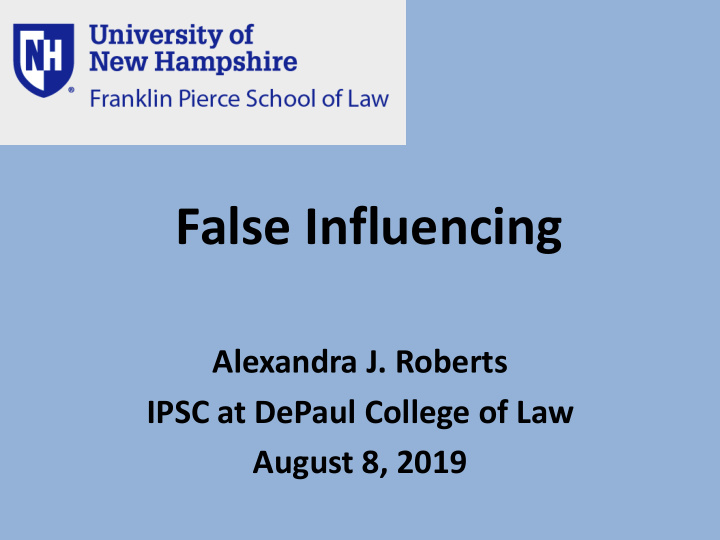



False Influencing Alexandra J. Roberts IPSC at DePaul College of Law August 8, 2019
Influencers • Who – Mega-, macro-, micro-, or nano- – Lifestyle, fashion, parenting, fitness, cooking, etc. – Receive payment, commission, free goods/services, or other material benefit to promote products • What – Projected $10-20B industry in 2020 – 86% of industry professionals to spend on IM in 2019 – Co.’s that used IM got a 520% return on every dollar* • Why – Followers: authenticity, trust, friendship, story – Brands: reach, engagement, low cost, loyal followers 2
FTC Guides • § 255.1(a): Endorsements must reflect the honest opinions, findings, beliefs, or experience of the endorser…and may not convey any express or implied representation that would be deceptive if made directly by the advertiser. • § 255.1(c): When the ad represents that the endorser uses the product, she must have been a bona fide user of it when she endorsed it. • § 255.5: If there is a material connection between an endorser and an advertiser, that connection should be clearly and conspicuously disclosed. 3
Lanham Act § 43(a) (1) Any person who, on or in connection with any goods or services, or any container for goods, uses in commerce any word, term, name, symbol, or device, or any combination thereof, or any false designation of origin, false or misleading description of fact, or false or misleading representation of fact, which… (B) in commercial advertising or promotion, misrepresents the nature, characteristics, qualities, or geographic origin of his or her or another person's goods, services, or commercial activities, shall be liable in a civil action by any person who believes that he or she is or is likely to be damaged by such act. 4
False or Misleading Advertising To establish a false/misleading ad claim, a π must prove: (1) a false statement of fact by Δ in a commercial advertisement about its own or another’s product (or business); (2) the statement actually deceived or has the tendency to deceive a substantial segment of its audience; (3) the deception is material, i.e. likely to influence the purchasing decision; (4) Δ caused its false statement to enter interstate commerce; (5) π has been or is likely to be injured as a result of the false statement, either by direct diversion of sales from itself to Δ or by a loss of goodwill. 5
Types of false/misleading ad claims • False – Literally false on its face • Establishment • Efficacy (non- establishment) – Literally false by necessary implication • Misleading 6
Types of influencer ad claims – False or misleading verbal claims – False or misleading visual claims – False or misleading personal testimonials – Nondisclosure of material benefit 7
Verbal claims (efficacy) 8
Verbal claims (establishment) 9
Visual claims (physical falsity) 10
Visual claims (photoshop falsity) 11
Personal testimonial claims 12
Personal testimonial claims 13
Nondisclosure 14
Nondisclosure 15
Nondisclosure + affirmative statement 16
Applying § 43(a)(1)(B) to influencer advertising claims 17
Questions? 18
Recommend
More recommend